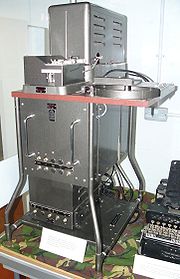
Rockex
Encyclopedia

One-time pad
In cryptography, the one-time pad is a type of encryption, which has been proven to be impossible to crack if used correctly. Each bit or character from the plaintext is encrypted by a modular addition with a bit or character from a secret random key of the same length as the plaintext, resulting...
cipher machine known to have been used by Britain and Canada
Canada
Canada is a North American country consisting of ten provinces and three territories. Located in the northern part of the continent, it extends from the Atlantic Ocean in the east to the Pacific Ocean in the west, and northward into the Arctic Ocean...
from 1943. It was developed by Benjamin deForest Bayly, working during the war for British Security Coordination
British Security Coordination
British Security Coordination was a covert organization set up in New York City by the British Secret Intelligence Service in May 1940 upon the authorization of Winston Churchill.-Operation:...
.
"Rockex" was named after the Rockefeller Center
Rockefeller Center
Rockefeller Center is a complex of 19 commercial buildings covering between 48th and 51st streets in New York City, United States. Built by the Rockefeller family, it is located in the center of Midtown Manhattan, spanning the area between Fifth Avenue and Sixth Avenue. It was declared a National...
, together with the tradition for naming British cipher equipment with the suffix "-ex" (e.g. Typex
Typex
In the history of cryptography, Typex machines were British cipher machines used from 1937. It was an adaptation of the commercial German Enigma with a number of enhancements that greatly increased its security....
).
In 1944 an improved Rockex II first appeared. There were also a Mark III and Mark V. After the war it was used by British consulates and embassies until 1973, although a few continued in use until the mid 1980s.
After WW2 the Rockex machines and the code tapes were manufactured in great secrecy under the control of the Secret Intelligence Service, MI6 at a small factory at Number 4 Chester Road, Borehamwood on the northern outskirts of London. To minimise the number of people who knew about the process, MI6's head of communications, Brigadier Gambier-Parry, took out a personal lease on the factory buildings and employed people through the local labour exchange as an entirely private venture ostensibly unconnected with government. The end product was then sold to the government departments who used the machines. This was not discovered by the UK Treasury until 1951 who were most concerned that no form of financial auditing had ever been exercised over the organisation. The Treasury officials were eventually convinced that the factory needed to be treated a special case and they allowed it to continue privately but with a special arrangements for top secret auditing (Natl Archives file T220/1444)

